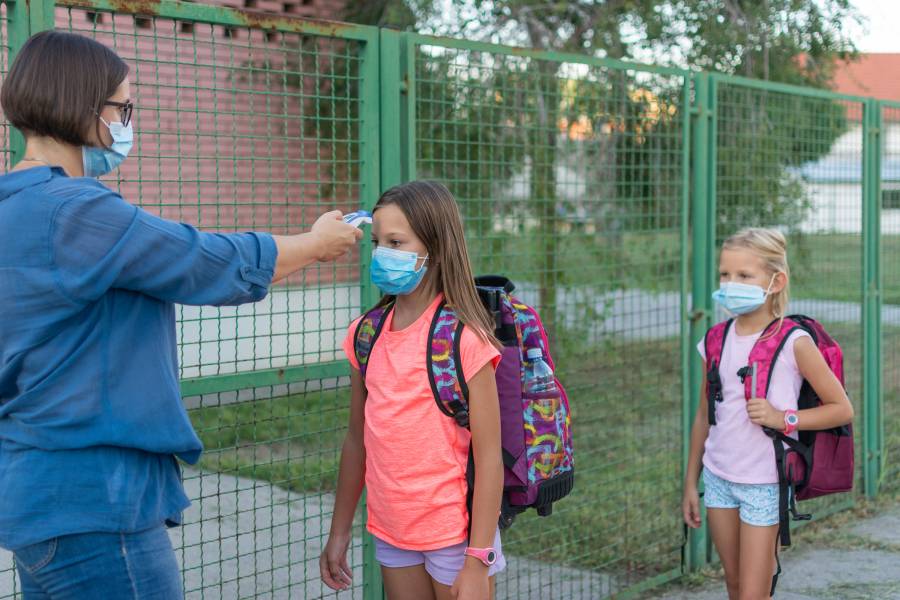People living with a child who attends school in-person have an increased risk of reporting evidence of COVID-19, but teacher masking, symptom screening, and other mitigation measures in schools may be able to minimize that excess risk, suggests a study led by researchers at the Johns Hopkins Bloomberg School of Public Health.
For their study, the researchers analyzed nearly 600,000 responses from an ongoing Facebook-based COVID-19 symptom survey in the United States over two periods between November 2020 and February 2021 before vaccines were widely available in the U.S. The researchers found that those living with a child engaged in full-time, in-person pre-K-to-12 schooling were about 38% more likely to report COVID-19-like symptoms such as fever, cough, or difficulty breathing compared to those living with a child schooled exclusively in a home setting.
A key finding was that school-based mitigation measures—the survey asked about 14 mitigation measures—were associated with less risk per mitigation measure. For example, 9% less risk of COVID-19-related illness per measure, and 7% less risk of a positive SARS-CoV-2 test per measure. Each additional mitigation measure reduced risk. Teacher masking and daily symptom screening appeared to be the strongest risk reducers.
The study was published online April 29 in Science.
The analysis included three outcomes as reported by survey respondents: COVID-19-like illness (i.e., fever and respiratory symptoms within the last 24 hours), loss of taste or smell within the last 24 hours, and a positive COVID-19 test in the last 14 days.
The survey responses indicated that most pre-K-to-12 schools had some mitigation measures in place, such as mask mandates for teachers, daily screening of students and teachers for symptoms, and curtailment of extracurricular activities. The researchers found that when schools used seven or more mitigation measures, the excess risk associated with in-person schooling mostly disappeared—and completely disappeared when 10 or more mitigation measures were reported.
"These findings support the idea that mitigation measures at schools can greatly reduce the excess COVID-19 risk to adults living with children who attend school in-person," says study first author Justin Lessler, an associate professor in the Department of Epidemiology at the Bloomberg School.
The issue of in-person schooling has been much debated in the United States from the start of the COVID-19 pandemic, leading to different school policies across the country. This policy diversity effectively set in motion a "natural experiment" with schooling and COVID-19 risk in the U.S. population. A chief concern has been that children going to school every day, even if they are not very susceptible to COVID-19 themselves, may bring home the virus to parents and other adult family members who are at higher risk of disease.
To examine these issues, Lessler and colleagues used the COVID-19 Symptom Survey, an ongoing Facebook-based survey managed by Carnegie Mellon University's Delphi Group in collaboration with Facebook that garners about 250,000 responses per week. The researchers looked at responses during two recent periods—roughly from Thanksgiving to Christmas last year and mid-January to mid-February this year—from respondents in households where at least one child was enrolled in a school, from pre-kindergarten through high school. Of the 576,051 people in this group, about 49%, or 284,789, reported being in a household with a child attending pre-K-to-12 school in-person rather than online or homeschooled.
In their analysis, Lessler and colleagues examined how the in-person school group differed from the online or homeschooled group in terms of reported COVID-19-related symptoms and outcomes. They adjusted the results to account for obvious confounding factors such as differences in local COVID-19 rates.
In addition to the 38% increase in the odds of getting a COVID-19-related illness among respondents in households with an in-person-schooled child, the researchers found a 21% increase in the odds for the loss of taste or smell—one of the core symptoms of COVID-19—and a 30% increase in the odds for testing positive for SARS-CoV-2 infection in the previous two weeks.
The strength of these associations appeared to increase with grade level. At the K and pre-K level, the association with COVID-19 outcomes was not significant for all outcomes, but the strength of those associations rose steadily, peaking at the grade 9-12 level—where the excess risk of a recent positive SARS-CoV-2 test for household members was over 50%. These findings are consistent with past studies suggesting less susceptibility to SARS-CoV-2 infection and COVID-19 illness among younger children compared to older ones.
The survey data included responses about COVID-19 mitigation measures in schools attended by children in the respondent's household. These mitigation measures included mask mandates for teachers and students, extra space between desks, suspension of school clubs, sports, and other extracurricular activities, and daily symptom screening among teachers and students. Respondents with a child in their household attending school in person reported a mean of 6.7 mitigation measures at school—with significant variations in that figure across the country, from a mean of 4.6 measures in South Dakota schools to 8.9 in Vermont schools.
The analysis also suggested that most of the increased COVID-19-related risk was concentrated in schools with fewer than seven mitigation measures, and that in-person schooling was not associated with increased risk for any COVID-19-related outcomes among respondents living with children in schools with ten or more measures.
"Because the study is based on a self-reported symptom survey and a setting where we can't randomize students to different schooling modes and mitigation measures, it has limitations," Lessler says. "But having hundreds of thousands of respondents and the ability to control for geographic and individual-level characteristics helps make up for those limitations."
He and his colleagues plan to follow up with studies of how in-person schooling and school-based mitigation measures affect community-wide spread of COVID-19.
Posted in Health
Tagged coronavirus, covid-19










